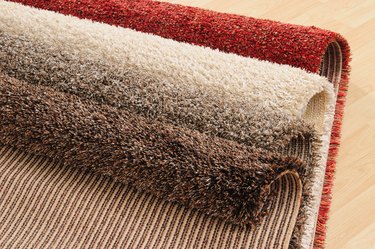
When choosing new carpet, you likely think about things like the color or the patterning in the fibers, but carpet pile height is also an important consideration in the look, feel and durability of the floor covering. Compare the types of pile and the height options to decide which one can hold up to the normal foot traffic in your space.
What Is Carpet Pile Height?
Video of the Day
Carpet pile is all of the visible fibers you see on the surface. Pile height, then, is the height or length of those fibers. Carpet is often described as having one of three heights:
Video of the Day
- Low-pile carpet: under 1/4 inch
- Medium-pile carpet: 1/4 inch to 1/2 inch
- High-pile carpet: 1/2 inch to 3/4 inch
Sometimes, carpets are even higher than 3/4 inch and are described as plush. You often see the greater pile height on shag-style carpet. The pile height you choose often depends on the area you're covering and your personal preference.
Low-Pile Carpet
Low-pile carpets usually have a tighter weave, a more dense texture and a smoother surface. One advantage of a low-pile carpet is the strength it offers. These shorter-pile rugs tend to hold up better than carpets with a longer pile. You can also vacuum and clean these types of carpets easier without as much dirt, pet hair and other debris getting stuck in the fibers.
The drawback of low-pile carpet is its feel. This carpet may feel less inviting and not as soft as a style with longer fibers. Some low-pile carpets may feel coarse on your bare feet, which doesn't fit well in an area such as your bedroom or living room where you want a softer, more luxurious feel.
Medium-Pile Carpet
Medium-pile carpet sits right between low and high piles, offering a balance of options. Think of it as a happy medium with perks of both types. You'll notice this type of carpet is softer than low-pile carpet, and it's easier to vacuum with less dirt getting trapped in it than high-pile carpet. It's still relatively easy to vacuum medium-pile carpet with a regular vacuum.
High-Pile Carpet
Go for a higher pile if you want the softest feel underfoot. This style of carpet typically has a looser appearance and looks and feels fluffy. It's good for adding warmth, softness and coziness to your space. You also get more texture because the surface is often imperfect and lush, sort of like tousled hair.
Higher-pile carpet adds more of a cushioning effect to your floors, which can be helpful if you have kids. The longer fibers may help dampen sound, and they offer a softer landing if your little one falls.
However, high-pile carpet is often harder to vacuum, and sometimes the longer fibers can get stuck in your vacuum. You may notice that dirt and other items get trapped in the fibers. That means allergens may get stuck in the carpet, which is a major drawback if you're an allergy sufferer. You may also have a harder time removing stains from the longer fibers.
Types of Carpet Pile
Carpet comes in two basic types of pile: cut and loop. They both use yarn, which can be made of different types of material, but the way they're finished is different. A cut carpet pile has ends that are cut, while loop carpet fibers remain uncut, creating a looped effect with the yarn. You can also find cut-loop carpets, which use a combination of the two types to create designs and sculptured effects.
Cut carpet tends to have a softer, denser feel, but it doesn't tend to hold up as well as loop-pile carpet. You can choose from different types of cut carpet, including frieze, shag, Saxony and velvet, each of which varies in the texture and twist in the fibers.
Loop carpet often has a tighter construction and is often more durable than cut carpet, making it the perfect solution for the busiest areas of your home. However, if you catch a loop on furniture or other items, you can pull it out or create a longer run in the carpet, which becomes a noticeable blemish on your floor.
- One Kings Lane: Rug Pile: The 5 Things You Need to Know
- Tufenkian: What Is Pile Height and Why Is It Important?
- Stainmaster: Pile & Thickness
- Pro! Flooring Brokers: Rug Pile Height: What to Know Before You Buy
- Floor Coverings International: Low or High Pile Carpet: What's Right for Your Family?
- Godfrey Hirst Carpets: Carpet Styles